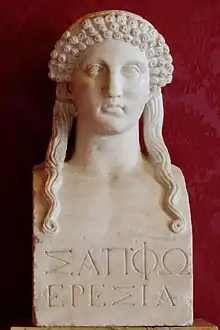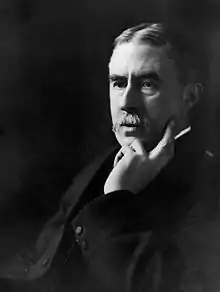Midnight poem
The "Midnight poem" is a fragment of Greek lyric poetry preserved by Hephaestion.[1] It is possibly by the archaic Greek poet Sappho, and is fragment 168 B in Eva-Maria Voigt's edition of her works. It is also sometimes known as PMG fr. adesp. 976 – that is, fragment 976 from Denys Page's Poetae Melici Graeci, not attributed to any author (fragmenta adespota). The poem, four lines describing a woman alone at night, is one of the best-known surviving pieces of Greek lyric poetry.[2] Long thought to have been composed by Sappho, it is one of the most frequently translated and adapted of the works ascribed to her.

Poem
Δέδυκε μὲν ἀ σελάννα |
The moon and the Pleiades have set, |
Four lines of the poem survive,[lower-alpha 2] preserved in Hephaestion's Enchiridion, a treatise on meter in Greek poetry.[6] Most scholars believe that this is only a fragment of a longer original, though Diskin Clay argues that the poem is complete as it is.[7] The poem is composed in an Aeolic meter known as the hagesichorean,[lower-alpha 3][8] in which lines are of the form "x – u u – u – –", where "–" represents a long syllable, "u" represents a short syllable, and "x" represents an anceps.[9]
The poem describes the speaker – a woman, as the adjective "μόνα" in the final line is feminine – lying alone at night. Clay suggests that this was intended to allude to, and contrast with, the myth of Selene and her mortal lover Endymion, who were reunited each night.[10] Other authors, such as Ulrich von Wilamowitz-Moellendorf, have read the poem as describing the speaker waiting for a lover. Paula Reiner and David Kovacs note, however, that the poem says nothing explicitly about waiting.[11] Instead, they suggest, the poem might equally well be read as a generalised complaint of loneliness rather than being specifically concerned with a lover's absence;[12] Odysseus Tsagarakis says that "the feeling of loneliness is most beautifully expressed by Sappho" in this fragment.[13]
Authorship
The midnight poem has generally been attributed to Sappho since the Renaissance,[1] initially by Arsenius Apostolius.[14] However, Hephaestion does not provide any attribution for the fragment,[1] and influential classicists such as Edgar Lobel, Denys Page and Ulrich von Wilamowitz-Moellendorf have questioned this attribution. Philologists generally consider the poem a folk song, attributable to no specific author.[15]
However, some classicists still attribute the poem to Sappho. It is included by Eva-Maria Voigt in her 1971 edition of Sappho's poems,[1] and modern editors and translators – including David Campbell,[16] and Diane Rayor and André Lardinois[17] – follow her in including the fragment amongst Sappho's poems. Clay has argued that the poem is by Sappho,[10] and Reiner and Kovacs argue that it was probably included in the Alexandrian edition of Sappho's works, though they note that this does not rule out the poem being a Hellenistic composition later wrongly attributed to Sappho.[18]
Denys Page argues against attributing the poem to Sappho on the basis of its dialect, which he believes is not the Aeolic dialect used by Sappho.[1] He identifies three separate features which he does not believe are consistent with the archaic Lesbian dialect found elsewhere in the works of Sappho and Alcaeus.[19] Other scholars have argued against Sapphic authorship of the fragment on the basis that Hephaestion does not attribute the poem to her; that the meter is otherwise unknown in Sappho's fragments; and that the poem "seems wrong for Sappho".[20] However, those who believe that Sappho did compose the poem argue that the evidence that the poem was not in Aeolic is "at best ambiguous",[lower-alpha 4][23] and find the other arguments put forward against Sappho's authorship unconvincing.[lower-alpha 5]
Dramatic setting
The poem mentions two astronomical observations: that both the moon and the Pleiades had been visible, and then set, before midnight. Based on these, Mebius and Herschberg calculate that the moon described in the poem is in a crescent phase.[26] The information about the Pleiades has been used to calculate the time of year that the poem is set: Mebius and Herschburg calculate that the dramatic date of the poem is between mid-January and late March;[26] Using more precise assumptions (that the poem was written by Sappho on Lesbos, around 570 BC, and that "midnight" refers to 00:00 at UT+1h46) Cuntz, Gurdemir, and George calculate that the Pleiades would have set before midnight from January 25 and would have been visible until March 31.[27]
Reiner and Kovacs have suggested that the common interpretation of the poem, that the Pleiades have set, is incorrect: they argue that the poem should be emended to read that the Pleiades are "in mid-heaven".[28] If this reading is correct, then the dramatic date of the poem would be some months earlier than that suggested by Mebius and Herschberg.[29]
Legacy

The poem is considered "one of the loveliest of all Greek lyrics", despite its briefness and simplicity.[2] Wilamowitz considered the poem to be a "charming folk song",[30] and Page too said that it has "a certain charm".[31]
Sappho's work has influenced many later poets, from Catullus' translation of Sappho 31[32] to the imagism of Ezra Pound, H.D., and Richard Aldington.[33] Clay identifies a number of classical works which may allude to the midnight poem, including Aristophanes' play Ecclesiazusae and the fifteenth of Ovid's Heroides.[34] The midnight poem is one of the most-frequently adapted of the poems attributed to Sappho – according to Clay, only fragment 31 has been more often translated.[35] In English, the midnight poem inspired Tennyson's "Mariana", and "Mariana in the South".[36] It also influenced A. E. Housman, who wrote three different poems based on the fragment: "The weeping Pleiads wester" and "The rainy Pleiads wester" from More Poems and "The half-moon westers low, my love" from Last Poems.[37] Other poems apparently alluding to the "midnight poem" include Elizabeth Bishop's "Insomnia" – whose first line fits the meter used in the Greek fragment, and which shares setting and tone with it – and H.D.'s "Night", which is thematically linked with the poem, also concerned with the passage of time and isolation.[38]
Notes
- As rendered in E. M. Voigt's Sappho et Alcaeus.[3] Denys Page's Poetae Melici Graecae has "σελάνα" rather than "σελάννα" on line 1 and "ἔρχεθ'" rather than "ἔρχετ'" on line 3.[4]
- Hephaestion arranges the poem over two lines; the four-line arrangement was first restored by Theodor Bergk.[5]
- Also known as an acephalous hipponactean, abbreviated as ^hipp. The name "hagesichorean" comes from Alcman's use of the metre in his first partheneion, a song for a chorus of young girls who praise Hagesichora, the leader of the chorus.
- Some word forms used in the poem, such as σελαννα, appear to suggest that the poem was in Aeolic;[21] the context in which Hephaestion cites the poem implies that the poem is in Aeolic;[1] and the poem can be plausibly emended so that it is in Aeolic.[22]
- Diskin Clay writes that "the fact that the poem is anonymous as it is cited in Hephaestion, in the abbreviated version of the Enchiridion that has come down to us, should have no weight in the balance."[24] Reiner and Kovacs dismiss Wilamowitz's argument that the content of the poem was wrong for Sappho on the grounds that it was primarily driven by a desire to protect "Sappho's good name".[25]
References
- Reiner & Kovacs 1993, p. 149
- Clay 1970, p. 119
- Voigt 1971, pp. 147–8
- Page 1962, p. 520
- Clay 1970, n. 1
- Clay 2011, pp. 3–4
- Clay 2011, p. 4
- Voigt 1971, p. 147
- Golston & Riad 2005, p. 93
- Clay 2011, p. 11
- Reiner & Kovacs 1993, p. 150
- Reiner & Kovacs 1993, p. 156
- Tsagarakis 1986, p. 11, n. 52
- Clay 1970, n. 3
- Clay 2011, pp. 4–5
- Campbell 1982, pp. 171–172
- Rayor & Lardinois 2014, p. 85
- Reiner & Kovacs 1993, p. 159
- Page 1958, p. 84
- Clay 1970, p. 121
- Reiner & Kovacs 1993, pp. 149–150
- Reiner & Kovacs 1993, p. 155
- Clay 1970, p. 123
- Clay 1970, p. 122
- Reiner & Kovacs 1993, pp. 150–151
- Mebius & Herschberg 1990, p. 150
- Cuntz, Gurdemir & George 2016, p. 21
- Reiner & Kovacs 1993, pp. 148–149
- Reiner & Kovacs 1993, n. 21
- Wilamowitz-Moellendorf 1886, p. 129, n. 7 in Reiner & Kovacs 1993, p. 150
- Page 1958, p. 85
- Most 1995, p. 30
- Reynolds 2001, p. 310
- Clay 2011, n. 5
- Clay 2011, p. 8
- Peterson 1994, p. 124
- Sanford 1942, p. 223
- Gellar-Goad 2015
Works cited
- Campbell, David A., ed. (1982). Greek Lyric I: Sappho and Alcaeus. Cambridge, Massachusetts: Harvard University Press.CS1 maint: ref=harv (link)
- Clay, Diskin (1970). "Fragmentum Adespotum 976". Transactions and Proceedings of the American Philological Association. 101.CS1 maint: ref=harv (link)
- Clay, Diskin (2011). "Sappho, Selanna, and the Poetry of the Night". Giornale Italiano di Filologia. 2 (1–2).CS1 maint: ref=harv (link)
- Cuntz, Manfred; Gurdemir, Levent; George, Martin (2016). "Seasonal Dating of Sappho's 'Midnight Poem' Revisited". Journal of Astronomical History and Heritage. 19 (1).CS1 maint: ref=harv (link)
- Gellar-Goad, T. H. M. (2015). "Sappho and Elizabeth Bishop on Lonely Moonlit Nights". Society for Classical Studies. Retrieved 4 May 2017.CS1 maint: ref=harv (link)
- Golston, C.; Riad, T. (2005). "The Phonology of Greek Lyric Meter" (PDF). Journal of Linguistics. 41.CS1 maint: ref=harv (link)
- Mebius, I. S.; Herschberg, J. E. (1990). "ΔΕΔΥΚΕ ΜΕΝ Α ΣΕΛΑΝΝΑ". Mnemosyne. 43 (1).CS1 maint: ref=harv (link)
- Most, Glenn (1995). "Reflecting Sappho". Bulletin of the Institute of Classical Studies. 40.CS1 maint: ref=harv (link)
- Page, Denys (1958). "ΔΕΔΥΚΕ ΜΕΝ Α ΣΕΛΑΝΝΑ". The Journal of Hellenic Studies. 78.CS1 maint: ref=harv (link)
- Page, Denys (1962). Poetae Melici Graecae. Oxford: Oxbow Books.CS1 maint: ref=harv (link)
- Peterson, Linda H. (1994). "Sappho and the Making of Tennysonian Lyric". ELH. 61 (1).CS1 maint: ref=harv (link)
- Rayor, Diane; Lardinois, André (2014). Sappho: A New Translation of the Complete Works. Cambridge: Cambridge University Press.CS1 maint: ref=harv (link)
- Reiner, Paula; Kovacs, David (1993). "ΔΕΔΥΚΕ ΜΕΝ Α ΣΕΛΑΝΝΑ: The Pleiades in Mid-Heaven (PMG Frag.Adesp. 976 = Sappho Fr. 168 B Voigt)". Mnemosyne. 43 (2).CS1 maint: ref=harv (link)
- Reynolds, Margaret (2001). The Sappho Companion. London: Vintage.CS1 maint: ref=harv (link)
- Sanford, Eva Matthews (1942). "Classical Poets in the Work of A. E. Housman". The Classical Journal. 37 (4).CS1 maint: ref=harv (link)
- Tsagarakis, Odysseus (1986). "Broken Hearts and the Social Circumstances in Sappho's Poetry". Rheinisches Museum für Philologie. 129 (1).CS1 maint: ref=harv (link)
- Voigt, E. M. (1971). Sappho et Alcaeus (in Latin). Amsterdam: Polak & Van Gennep.CS1 maint: ref=harv (link)
- Wilamowitz-Moellendorf, Ulrich von (1886). Isyllos von Epidauros (in German). Berlin: Weidmannsche Buchhandlung.CS1 maint: ref=harv (link)